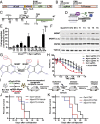Versatile in vivo regulation of tumor phenotypes by dCas9-mediated transcriptional perturbation
- PMID: 27325776
- PMCID: PMC4941480
- DOI: 10.1073/pnas.1600582113
Versatile in vivo regulation of tumor phenotypes by dCas9-mediated transcriptional perturbation
Abstract
Targeted transcriptional regulation is a powerful tool to study genetic mediators of cellular behavior. Here, we show that catalytically dead Cas9 (dCas9) targeted to genomic regions upstream or downstream of the transcription start site allows for specific and sustainable gene-expression level alterations in tumor cells in vitro and in syngeneic immune-competent mouse models. We used this approach for a high-coverage pooled gene-activation screen in vivo and discovered previously unidentified modulators of tumor growth and therapeutic response. Moreover, by using dCas9 linked to an activation domain, we can either enhance or suppress target gene expression simply by changing the genetic location of dCas9 binding relative to the transcription start site. We demonstrate that these directed changes in gene-transcription levels occur with minimal off-target effects. Our findings highlight the use of dCas9-mediated transcriptional regulation as a versatile tool to reproducibly interrogate tumor phenotypes in vivo.
Keywords: CRISPR; cancer genetics; cancer models; cancer therapeutic resistance; gene regulation.
Conflict of interest statement
The authors declare no conflict of interest.
Figures






References
-
- Pettersson E, Lundeberg J, Ahmadian A. Generations of sequencing technologies. Genomics. 2009;93(2):105–111. - PubMed
Publication types
MeSH terms
Substances
Grants and funding
LinkOut - more resources
Full Text Sources
Other Literature Sources
Molecular Biology Databases

